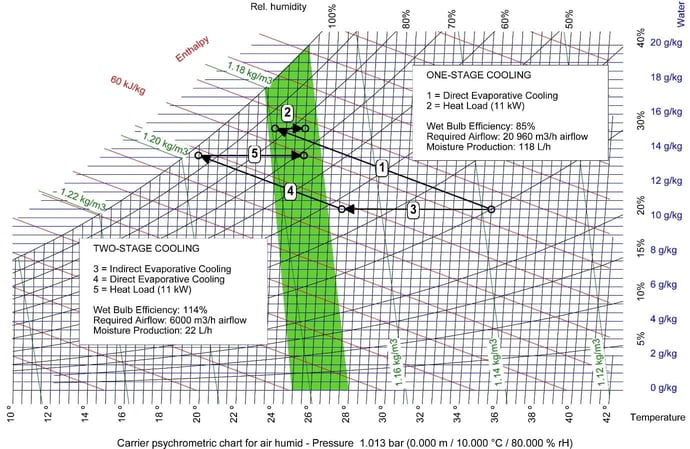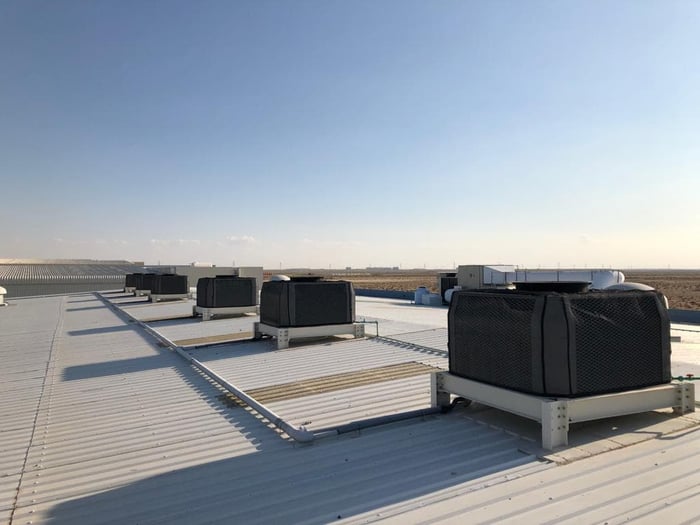Does evaporative cooling work in humid climates? The short answer is yes, but it depends on the type of evaporative system you use.
Evaporative cooling is a physical process based on water evaporation, meaning that the relative humidity affects the effectiveness of the chosen system. The hotter and dryer a climate is, the higher the performance of an evaporative cooling system. An indirect/direct evaporative system will consistently outperform the direct evaporative systems. The more humid a climate is, the harder it is for a direct evaporative cooling system to cool effectively. This being said, indirect/direct evaporative cooling systems hold their performance far better in more humid regions, such as coastal areas, during the humid hours.
The great benefit of two-stage (indirect/direct) evaporative cooling, as opposed to direct evaporative systems, is that it uses both the indirect and the direct cooling process. As a result, Oxycom's IntrCooll can cool up to 7 ℃ deeper than other evaporative cooling systems. Recent practice results from indirect/direct cooling projects in Riyadh with outside temperatures of 48 to 52 ℃ and dry air resulted in incoming temperatures around 11 ℃. The wet bulb was around 20 ℃, resulting in a wet-bulb efficiency of the system of up to 135%. A direct evaporative cooler would reach maximum efficiency of 85% resulting in incoming air temperatures of around 22 ℃. The advantage of the indirect/direct cooling technology in more humid climates will reach at least 114% wet bulb efficiency; for direct evaporative systems, this will be around 85%.

The graphic shows an example of a one-stage evaporative cooling process vs a two-stage evaporative cooling process with outdoor air at 35 °C and 30% relative humidity. We can see that a one-stage evaporative cooling process produces indoor air with a higher humidity content than a two-stage evaporative cooling process (~80% vs ~69%). Furthermore, the wet-bulb efficiency of a one-stage evaporative cooling process is lower than a two-stage evaporative cooling process (85% vs 114%). Finally, the required airflow to achieve the same indoor temperature of 25 °C at the same heat load (11 kW) is more than 3 times higher in case of a one-stage evaporative cooling process (20 960 m3 /h vs 6000 m3 /h). This implies that the moisture production of a one-stage evaporative cooling process is more than 5 times higher (118 L/h vs 22 L/h).
Read more on our page: Effectiveness of evaporative cooling in different climates.
Semi-hybrid solution based on two-stage evaporative cooling
Yet, evaporative cooling remains a physical process: with a relative humidity of 80% or 90%, a two-stage evaporative system cannot cool as effectively as at lower humidity levels. For instance, some desert/seaside climate countries, such as Dubai, can experience long, hot, and humid periods. In this case, a semi-hybrid evaporative cooling system can provide an optimal cooling solution. This combines a two-stage evaporative cooling system with a regular yet small mechanical cooling system.
The mechanical system switches on only when the adiabatic system cannot provide the required temperature during the more humid days of the year. With this semi-hybrid system, a production hall or building can be cooled adequately throughout the year without losing the extensive energy-saving benefits of evaporative cooling. In fact, up to 90% of the time, the indirect/direct evaporative cooling system can work stand-alone.
The semi-hybrid system in use
In light of the global efforts to reduce CO2 and the recent pandemic, energy-saving and fresh air are no longer a luxury but a necessity. Consequently, Almarai, a dairy company in Saudi Arabia, felt the need to replace their compressor-based packaged AC units in the Old Guesthouse, which functions as a reception hall for their customers. Under the extreme conditions of the changing climate in Saudi Arabia, the compressors of these AC units consumed massive amounts of energy to deliver the demanded cooling capacity and fresh air. To save on energy consumption and CO2 emissions, Almarai looked to new cooling technologies without forgoing a comfortable climate in the Old Guesthouse. A semi-hybrid comfort cooling solution based on Oxycom's patented two-stage evaporative cooling technology proved to be the solution with the best result. You can read more about this sustainable and healthy solution in Almarai's case study. Download the case study via the button below:
For more information on the efficiency of evaporative cooling vs air conditioning, check our page: Evaporative cooling vs air conditioning.





